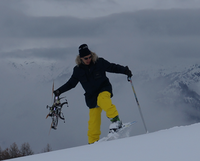
The drone has been developed within the SHERPA project funded by European Community involving seven European Universities, two companies and the end user CAI (Italian Alpine Club). The University of Bologna is coordinating the research with the team led by Lorenzo Marconi, Department of Electrical, Electronic and Information Engineering “Guglielmo Marconi”.
The research studies innovative solutions to speed up search and rescue operations in case of avalanches. The idea is to use a drone equipped with an ARTVA receiver and other sensors to patrol large areas in short time and to localize missing by saving time. The timeliness of rescue is, in these cases, essential in order to save missing people overwhelmed by avalanches. Often the victim is located in places that are difficult to reach and very dangerous for the rescuers.
The team led by Lorenzo Marconi, after several laboratory tests, brought the prototype built by the Aslatech Company (the project partner) in the mountains to test it under real operating conditions. In the ski resort of Pila (AO) two days of testing has been conducted in collaboration with the Val d'Aosta Mountain Rescue team performing training activities on site for their rescue unit. The tests focused mainly on the analysis of flight performance in mountain environment, with adverse weather conditions, as well as on the feasibility of accurate detection of a signal emitted by a transmitter (beacon) under the snow, simulating the victim, through the ARTVA receiver installed aboard the drone.
After two days of tests the team of the University of Bologna is very satisfied about the results achieved, as reported by Roberto Naldi, UniBo researcher participating in the experiments:
“The drone was able to identify a hidden detector 300 meters away, under a meter of snow, in less than a minute. All tests on the functionality of the drone gave a positive result. Any problem has occurred concerning the transmitter, the functionality of the motors, the on-board electronics and wifi communication system. Remain to improve, however, the communication range and battery life, which are affected by low temperatures decreasing voltages”.
All experiments were performed at an altitude of about 2000 meters with a few degrees below zero temperatures. The tests were also conducted in the presence of moderate snowfall and fog and with little wind.
The researchers are already thinking about future developments: the winter use of the drone will be followed by summer experimentation for the research of the missing in woods and forests with the help also of a ground rover. The project, started one year ago and lasting four years, includes also the development of heterogeneous robotic platforms composed by different ground and aerial elements.
